Attached files
| file | filename |
|---|---|
| EX-99.1 - EX-99.1 - Cerence Inc. | crnc-ex991_6.htm |
| 8-K - 8-K - Cerence Inc. | crnc-8k_20210208.htm |
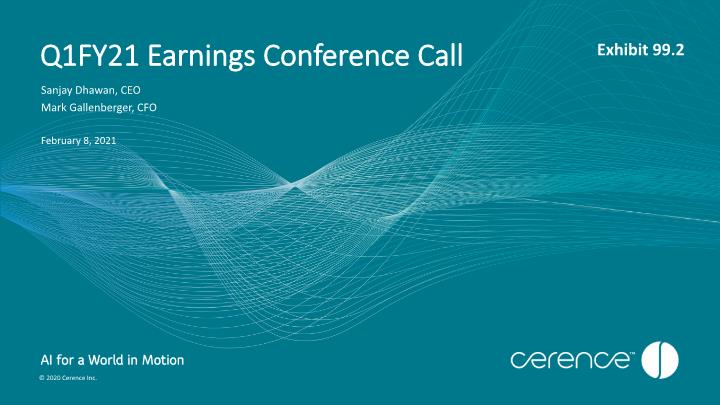
Q1FY21 Earnings Conference Call Sanjay Dhawan, CEO Mark Gallenberger, CFO February 8, 2021 Exhibit 99.2
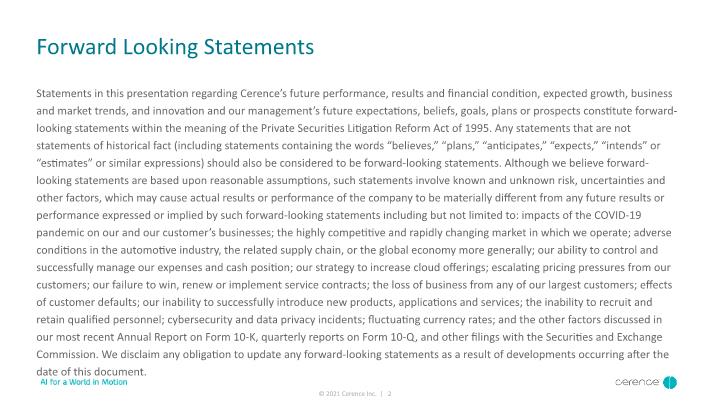
Forward Looking Statements Statements in this presentation regarding Cerence’s future performance, results and financial condition, expected growth, business and market trends, and innovation and our management’s future expectations, beliefs, goals, plans or prospects constitute forward-looking statements within the meaning of the Private Securities Litigation Reform Act of 1995. Any statements that are not statements of historical fact (including statements containing the words “believes,” “plans,” “anticipates,” “expects,” “intends” or “estimates” or similar expressions) should also be considered to be forward-looking statements. Although we believe forward-looking statements are based upon reasonable assumptions, such statements involve known and unknown risk, uncertainties and other factors, which may cause actual results or performance of the company to be materially different from any future results or performance expressed or implied by such forward-looking statements including but not limited to: impacts of the COVID-19 pandemic on our and our customer’s businesses; the highly competitive and rapidly changing market in which we operate; adverse conditions in the automotive industry, the related supply chain, or the global economy more generally; our ability to control and successfully manage our expenses and cash position; our strategy to increase cloud offerings; escalating pricing pressures from our customers; our failure to win, renew or implement service contracts; the loss of business from any of our largest customers; effects of customer defaults; our inability to successfully introduce new products, applications and services; the inability to recruit and retain qualified personnel; cybersecurity and data privacy incidents; fluctuating currency rates; and the other factors discussed in our most recent Annual Report on Form 10-K, quarterly reports on Form 10-Q, and other filings with the Securities and Exchange Commission. We disclaim any obligation to update any forward-looking statements as a result of developments occurring after the date of this document. 2
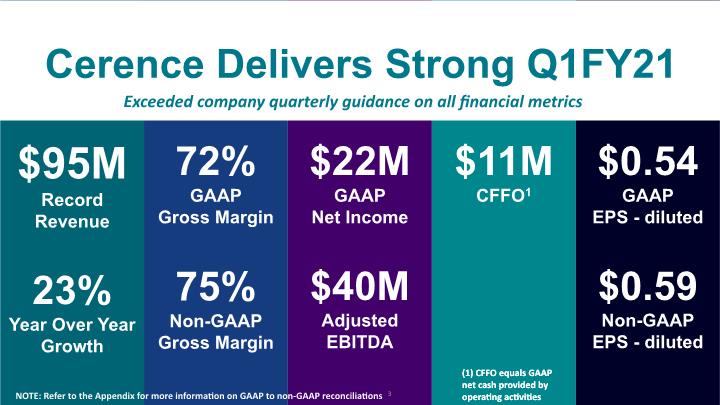
(1) CFFO equals GAAP net cash provided by operating activities 3 (1) CFFO equals GAAP net cash provided by operating activities NOTE: Refer to the Appendix for more information on GAAP to non-GAAP reconciliations Exceeded company quarterly guidance on all financial metrics Cerence Delivers Strong Q1FY21
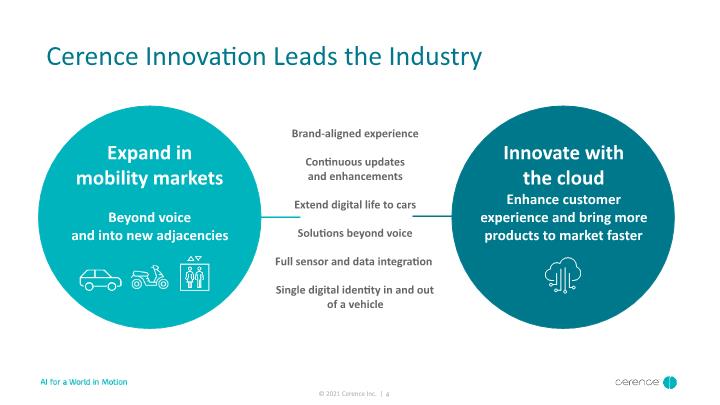
4 Brand-aligned experience Continuous updates and enhancements Extend digital life to cars Solutions beyond voice Full sensor and data integration Single digital identity in and out of a vehicle Innovate with the cloud Enhance customer experience and bring more products to market faster Expand in mobility markets Beyond voice and into new adjacencies Cerence Innovation Leads the Industry

5 © 2021 Cerence Inc. | Ecosystem of Services and Domains Cerence Connect Cerence Tour Guide Cerence Browse Cerence Reader Cerence Extend Interactive Entertainment Cerence Car Life Cerence Pay One Click Payment Customer Engagement Revenue Sharing Monetized Services Dealer Assistant Vehicle Knowledge Vehicle Health Music Thriller Quiz Karaoke … Interactive Navigation News Reader Voice Clone Expanding with Cerence Cloud
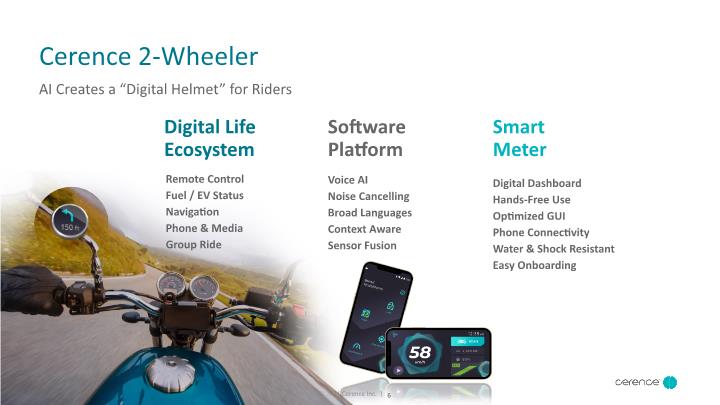
Software Platform Voice AI Noise Cancelling Broad Languages Context Aware Sensor Fusion Digital Life Ecosystem Remote Control Fuel / EV Status Navigation Phone & Media Group Ride Smart Meter Digital Dashboard Hands-Free Use Optimized GUI Phone Connectivity Water & Shock Resistant Easy Onboarding Cerence 2-Wheeler AI Creates a “Digital Helmet” for Riders 6

7 © 2021 Cerence Inc. | Robust Software Cloud Services and Toolkits Cloud Speech Voice-Powered Directories Dynamic Content Analytics Diagnostic Channel Remote Provisions OTA Updates AI Software Defined Module Automotive Grade Touchless Control Multilingual Support Edge Technologies Language Updates Device Upgrades Status and Issue Checks AI Module Car Call Hall Call AI Module Cerence Building Mobility AI for a World in Vertical Motion 7
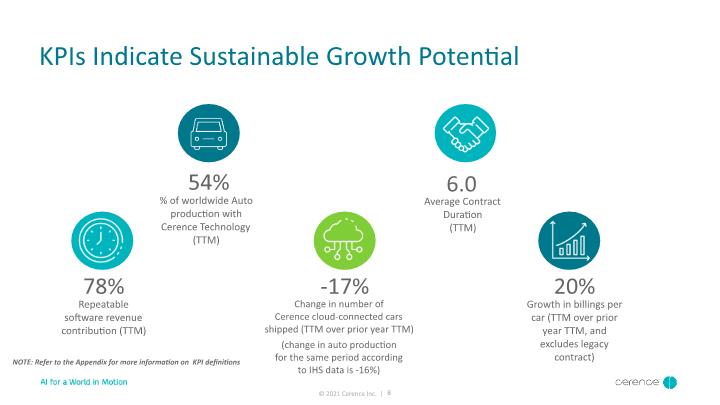
8 KPIs Indicate Sustainable Growth Potential 8 78% Repeatable software revenue contribution (TTM) -17% Change in number of Cerence cloud-connected cars shipped (TTM over prior year TTM) (change in auto production for the same period according to IHS data is -16%) 20% Growth in billings per car (TTM over prior year TTM, and excludes legacy contract) % of worldwide Auto production with Cerence Technology (TTM) Average Contract Duration (TTM) 54% 6.0 NOTE: Refer to the Appendix for more information on KPI definitions
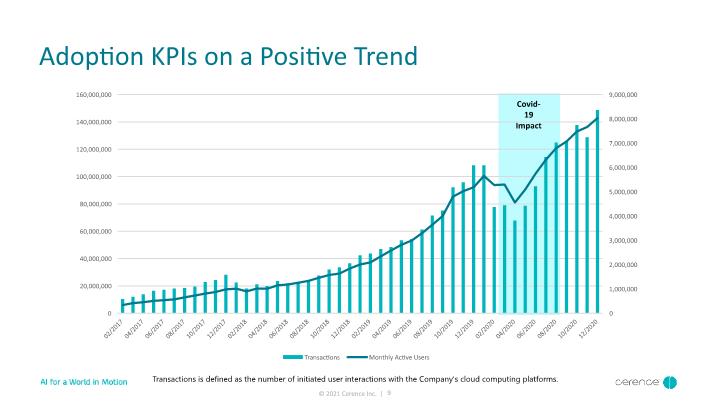
Adoption KPIs on a Positive Trend 9 Covid-19 Impact Transactions is defined as the number of initiated user interactions with the Company's cloud computing platforms.
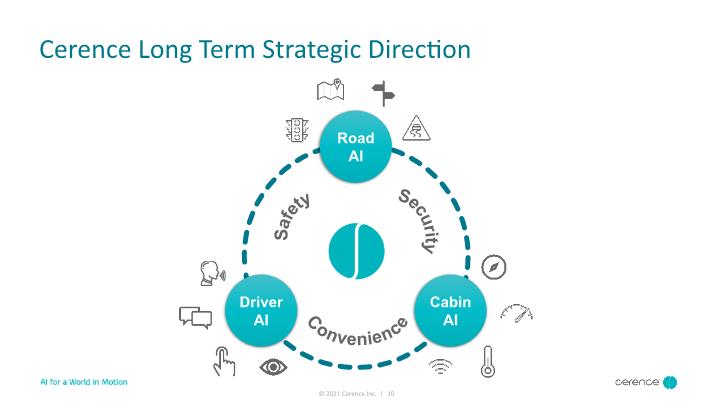
Road AI Cabin AI Driver AI Safety Convenience Security Cerence Long Term Strategic Direction 10
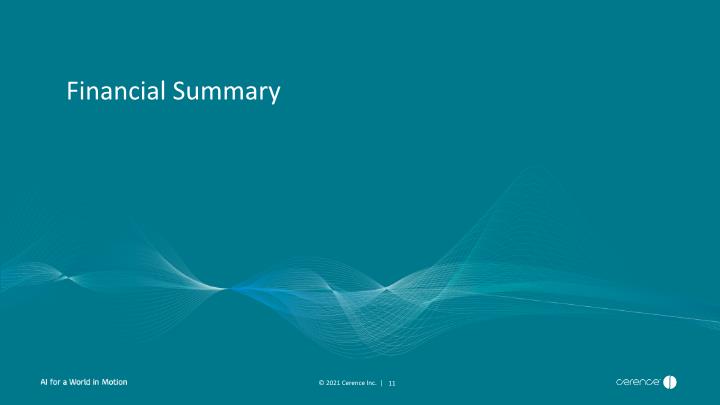
Financial Summary 11

Q1 Exceeded Street Guidance on All Key Financial Metrics 12 Footnote: Non-GAAP excludes acquisition-related costs, amortization of acquired intangible assets, restructuring expense, and stock-based compensation. Refer to the Appendix for more information on GAAP to non-GAAP reconciliations
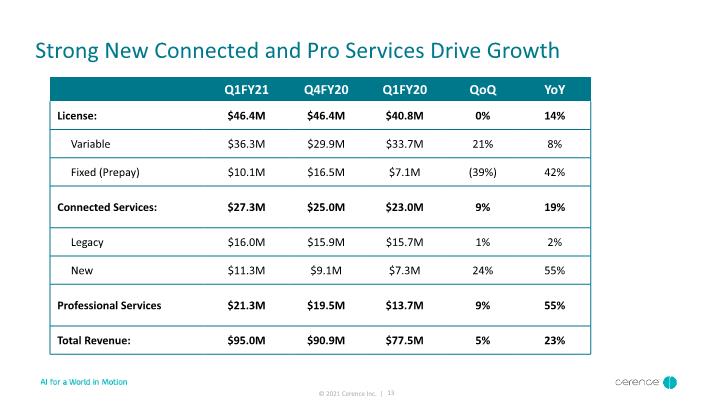
Strong New Connected and Pro Services Drive Growth 13
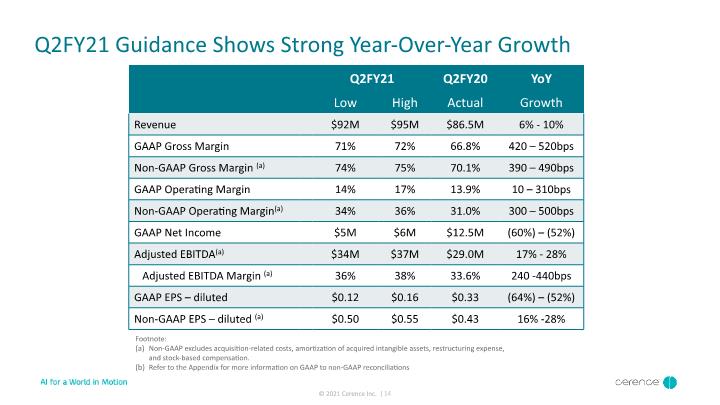
Q2FY21 Guidance Shows Strong Year-Over-Year Growth 14 Footnote: Non-GAAP excludes acquisition-related costs, amortization of acquired intangible assets, restructuring expense, and stock-based compensation. Refer to the Appendix for more information on GAAP to non-GAAP reconciliations
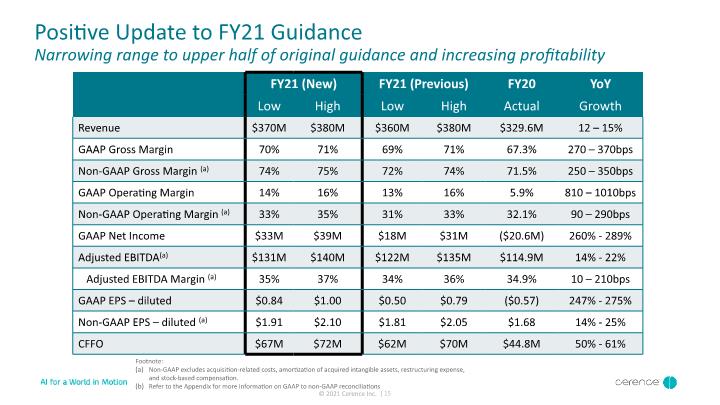
Positive Update to FY21 Guidance Narrowing range to upper half of original guidance and increasing profitability 15 Footnote: Non-GAAP excludes acquisition-related costs, amortization of acquired intangible assets, restructuring expense, and stock-based compensation. Refer to the Appendix for more information on GAAP to non-GAAP reconciliations

Thank You!
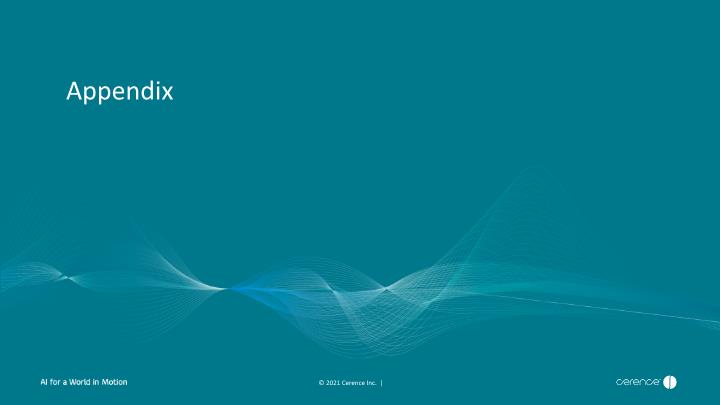
Appendix
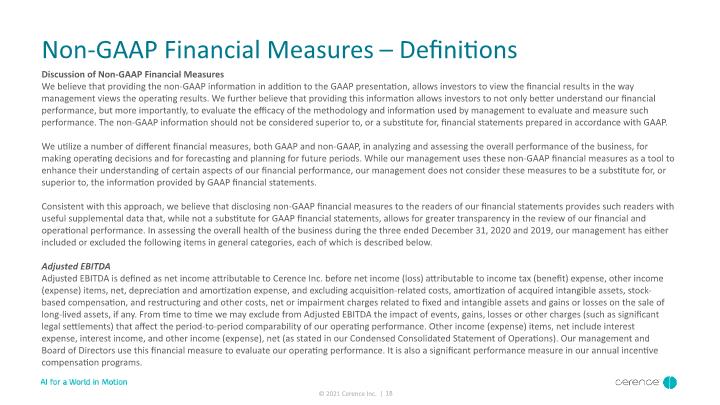
18 Non-GAAP Financial Measures – Definitions Discussion of Non-GAAP Financial Measures We believe that providing the non-GAAP information in addition to the GAAP presentation, allows investors to view the financial results in the way management views the operating results. We further believe that providing this information allows investors to not only better understand our financial performance, but more importantly, to evaluate the efficacy of the methodology and information used by management to evaluate and measure such performance. The non-GAAP information should not be considered superior to, or a substitute for, financial statements prepared in accordance with GAAP. We utilize a number of different financial measures, both GAAP and non-GAAP, in analyzing and assessing the overall performance of the business, for making operating decisions and for forecasting and planning for future periods. While our management uses these non-GAAP financial measures as a tool to enhance their understanding of certain aspects of our financial performance, our management does not consider these measures to be a substitute for, or superior to, the information provided by GAAP financial statements. Consistent with this approach, we believe that disclosing non-GAAP financial measures to the readers of our financial statements provides such readers with useful supplemental data that, while not a substitute for GAAP financial statements, allows for greater transparency in the review of our financial and operational performance. In assessing the overall health of the business during the three ended December 31, 2020 and 2019, our management has either included or excluded the following items in general categories, each of which is described below. Adjusted EBITDA Adjusted EBITDA is defined as net income attributable to Cerence Inc. before net income (loss) attributable to income tax (benefit) expense, other income (expense) items, net, depreciation and amortization expense, and excluding acquisition-related costs, amortization of acquired intangible assets, stock-based compensation, and restructuring and other costs, net or impairment charges related to fixed and intangible assets and gains or losses on the sale of long-lived assets, if any. From time to time we may exclude from Adjusted EBITDA the impact of events, gains, losses or other charges (such as significant legal settlements) that affect the period-to-period comparability of our operating performance. Other income (expense) items, net include interest expense, interest income, and other income (expense), net (as stated in our Condensed Consolidated Statement of Operations). Our management and Board of Directors use this financial measure to evaluate our operating performance. It is also a significant performance measure in our annual incentive compensation programs.
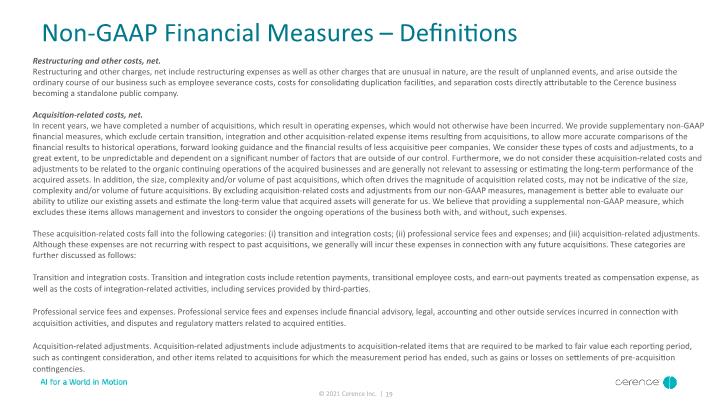
19 Non-GAAP Financial Measures – Definitions Restructuring and other costs, net. Restructuring and other charges, net include restructuring expenses as well as other charges that are unusual in nature, are the result of unplanned events, and arise outside the ordinary course of our business such as employee severance costs, costs for consolidating duplication facilities, and separation costs directly attributable to the Cerence business becoming a standalone public company. Acquisition-related costs, net. In recent years, we have completed a number of acquisitions, which result in operating expenses, which would not otherwise have been incurred. We provide supplementary non-GAAP financial measures, which exclude certain transition, integration and other acquisition-related expense items resulting from acquisitions, to allow more accurate comparisons of the financial results to historical operations, forward looking guidance and the financial results of less acquisitive peer companies. We consider these types of costs and adjustments, to a great extent, to be unpredictable and dependent on a significant number of factors that are outside of our control. Furthermore, we do not consider these acquisition-related costs and adjustments to be related to the organic continuing operations of the acquired businesses and are generally not relevant to assessing or estimating the long-term performance of the acquired assets. In addition, the size, complexity and/or volume of past acquisitions, which often drives the magnitude of acquisition related costs, may not be indicative of the size, complexity and/or volume of future acquisitions. By excluding acquisition-related costs and adjustments from our non-GAAP measures, management is better able to evaluate our ability to utilize our existing assets and estimate the long-term value that acquired assets will generate for us. We believe that providing a supplemental non-GAAP measure, which excludes these items allows management and investors to consider the ongoing operations of the business both with, and without, such expenses. These acquisition-related costs fall into the following categories: (i) transition and integration costs; (ii) professional service fees and expenses; and (iii) acquisition-related adjustments. Although these expenses are not recurring with respect to past acquisitions, we generally will incur these expenses in connection with any future acquisitions. These categories are further discussed as follows: Transition and integration costs. Transition and integration costs include retention payments, transitional employee costs, and earn-out payments treated as compensation expense, as well as the costs of integration-related activities, including services provided by third-parties. Professional service fees and expenses. Professional service fees and expenses include financial advisory, legal, accounting and other outside services incurred in connection with acquisition activities, and disputes and regulatory matters related to acquired entities. Acquisition-related adjustments. Acquisition-related adjustments include adjustments to acquisition-related items that are required to be marked to fair value each reporting period, such as contingent consideration, and other items related to acquisitions for which the measurement period has ended, such as gains or losses on settlements of pre-acquisition contingencies.

Non-GAAP Financial Measures – Definitions Amortization of acquired intangible assets. We exclude the amortization of acquired intangible assets from non-GAAP expense and income measures. These amounts are inconsistent in amount and frequency and are significantly impacted by the timing and size of acquisitions. Providing a supplemental measure which excludes these charges allows management and investors to evaluate results “as-if” the acquired intangible assets had been developed internally rather than acquired and, therefore, provides a supplemental measure of performance in which our acquired intellectual property is treated in a comparable manner to our internally developed intellectual property. Although we exclude amortization of acquired intangible assets from our non-GAAP expenses, we believe that it is important for investors to understand that such intangible assets contribute to revenue generation. Amortization of intangible assets that relate to past acquisitions will recur in future periods until such intangible assets have been fully amortized. Future acquisitions may result in the amortization of additional intangible assets. Non-cash expenses. We provide non-GAAP information relative to the following non-cash expenses: (i) stock-based compensation; and (ii) non-cash interest. These items are further discussed as follows: (i)Stock-based compensation. Because of varying valuation methodologies, subjective assumptions and the variety of award types, we exclude stock-based compensation from our operating results. We evaluate performance both with and without these measures because compensation expense related to stock-based compensation is typically non-cash and awards granted are influenced by the Company’s stock price and other factors such as volatility that are beyond our control. The expense related to stock-based awards is generally not controllable in the short-term and can vary significantly based on the timing, size and nature of awards granted. As such, we do not include such charges in operating plans. Stock-based compensation will continue in future periods. ii)Non-cash interest. We exclude non-cash interest because we believe that excluding this expense provides management, as well as other users of the financial statements, with a valuable perspective on the cash-based performance and health of the business, including the current near-term projected liquidity. Non-cash interest expense will continue in future periods. Other expenses. We exclude certain other expenses that result from unplanned events outside the ordinary course of continuing operations, in order to measure operating performance and current and future liquidity both with and without these expenses. By providing this information, we believe management and the users of the financial statements are better able to understand the financial results of what we consider to be our organic, continuing operations. Included in these expenses are items such as other charges (credits), net, losses from extinguishment of debt, and changes in indemnification assets corresponding with the release of pre-spin liabilities for uncertain tax positions. 20

KPI Measures – Definitions Key performance indicators We believe that providing key performance indicators (“KPIs”), allows investors to gain insight into the way management views the performance of the business. We further believe that providing KPIs allows investors to better understand information used by management to evaluate and measure such performance. KPIs should not be considered superior to, or a substitute for, operating results prepared in accordance with GAAP. In assessing the performance of the business during the three months ended December 31, 2020 and 2019, our management has reviewed the following KPIs, each of which is described below: • Percent of worldwide auto production with Cerence Technology: The number of Cerence enabled cars shipped as compared to IHS Markit car production data. • Average contract duration: The weighted average annual period over which we expect to recognize the estimated revenues from new license and connected contracts signed during the quarter, calculated on a trailing twelve months (“TTM”) basis and presented in years. • Repeatable software contribution: The percentage of repeatable revenues as compared to total GAAP revenue in the quarter on a TTM basis. Repeatable revenues are defined as the sum of License and Connected Services revenues. • Change in number of Cerence connected cars shipped: The year over year change in the number of cars shipped with Cerence connected solutions. Amounts calculated on a TTM basis. • Growth in billings per car: The rate of growth calculated from the average billings per car based on a trailing twelve month comparison while excluding legacy contract and adjusted for prepay usage. 21
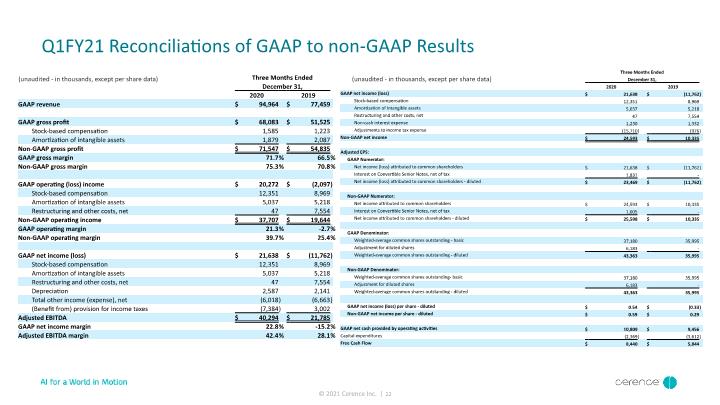
22 Q1FY21 Reconciliations of GAAP to non-GAAP Results (unaudited - in thousands, except per share data) (unaudited - in thousands, except per share data) Three Months Ended December 31, 2020 2019 GAAP revenue $94,964 $77,459 GAAP gross profit $68,083 $51,525 Stock-based compensation 1,585 1,223 Amortization of intangible assets 1,879 2,087 Non-GAAP gross profit $71,547 $54,835 GAAP gross margin 71.7% 66.5% Non-GAAP gross margin 75.3% 70.8% GAAP operating (loss) income $20,272 $(2,097) Stock-based compensation 12,351 8,969 Amortization of intangible assets 5,037 5,218 Restructuring and other costs, net 47 7,554 Non-GAAP operating income $37,707 $19,644 GAAP operating margin 21.3% -2.7% Non-GAAP operating margin 39.7% 25.4% GAAP net income (loss) $21,638 $(11,762) Stock-based compensation 12,351 8,969 Amortization of intangible assets 5,037 5,218 Restructuring and other costs, net 47 7,554 Depreciation 2,587 2,141 Total other income (expense), net (6,018) (6,663) (Benefit from) provision for income taxes (7,384) 3,002 Adjusted EBITDA $40,294 $21,785 GAAP net income margin 22.8% -15.2% Adjusted EBITDA margin 42.4% 28.1% Three Months Ended December 31, 2020 2019 GAAP net income (loss) $21,638 $(11,762) Stock-based compensation 12,351 8,969 Amortization of intangible assets 5,037 5,218 Restructuring and other costs, net 47 7,554 Non-cash interest expense 1,230 1,332 Adjustments to income tax expense (15,710) (976) Non-GAAP net income $24,593 $10,335 Adjusted EPS: GAAP Numerator: Net income (loss) attributed to common shareholders $21,638 $(11,762) Interest on Convertible Senior Notes, net of tax 1,831 - Net income (loss) attributed to common shareholders - diluted $23,469 $(11,762) Non-GAAP Numerator: Net income attributed to common shareholders $24,593 $10,335 Interest on Convertible Senior Notes, net of tax 1,005 - Net income attributed to common shareholders - diluted $25,598 $10,335 GAAP Denominator: Weighted-average common shares outstanding - basic 37,180 35,995 Adjustment for diluted shares 6,183 - Weighted-average common shares outstanding - diluted 43,363 35,995 Non-GAAP Denominator: Weighted-average common shares outstanding- basic 37,180 35,995 Adjustment for diluted shares 6,183 - Weighted-average common shares outstanding - diluted 43,363 35,995 GAAP net income (loss) per share - diluted $0.54 $(0.33) Non-GAAP net income per share - diluted $0.59 $0.29 GAAP net cash provided by operating activities $10,809 $9,456 Capital expenditures (2,369) (3,612) Free Cash Flow $8,440 $5,844

23 Calculation of Repeatable Revenue Software Contribution (unaudited - in thousands) Q1FY21 Q4FY20 Q3FY20 Q2FY20 GAAP revenues $94,964 $90,882 $74,810 $86,495 Less: Professional services revenue 21,299 19,457 17,360 18,742 Non-GAAP Repeatable revenues $73,665 $71,425 $57,450 $67,753 GAAP revenues TTM $347,151 Less: Professional services revenue TTM 76,858 Non-GAAP Repeatable revenues TTM $270,293 Repeatable software contribution 78%
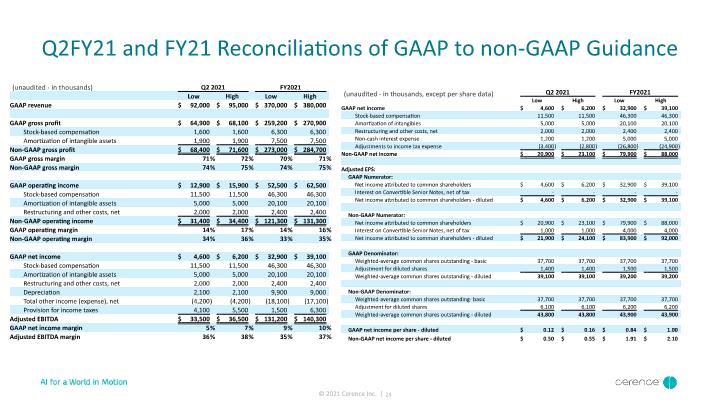
24 Q2FY21 and FY21 Reconciliations of GAAP to non-GAAP Guidance (unaudited - in thousands) (unaudited - in thousands, except per share data) Q2 2021 FY2021 Low High Low High GAAP revenue $92,000 $95,000 $370,000 $380,000 GAAP gross profit $64,900 $68,100 $259,200 $270,900 Stock-based compensation 1,600 1,600 6,300 6,300 Amortization of intangible assets 1,900 1,900 7,500 7,500 Non-GAAP gross profit $68,400 $71,600 $273,000 $284,700 GAAP gross margin 71% 72% 70% 71% Non-GAAP gross margin 74% 75% 74% 75% GAAP operating income $12,900 $15,900 $52,500 $62,500 Stock-based compensation 11,500 11,500 46,300 46,300 Amortization of intangible assets 5,000 5,000 20,100 20,100 Restructuring and other costs, net 2,000 2,000 2,400 2,400 Non-GAAP operating income $31,400 $34,400 $121,300 $131,300 GAAP operating margin 14% 17% 14% 16% Non-GAAP operating margin 34% 36% 33% 35% GAAP net income $4,600 $6,200 $32,900 $39,100 Stock-based compensation 11,500 11,500 46,300 46,300 Amortization of intangible assets 5,000 5,000 20,100 20,100 Restructuring and other costs, net 2,000 2,000 2,400 2,400 Depreciation 2,100 2,100 9,900 9,000 Total other income (expense), net (4,200) (4,200) (18,100) (17,100) Provision for income taxes 4,100 5,500 1,500 6,300 Adjusted EBITDA $33,500 $36,500 $131,200 $140,300 GAAP net income margin 5% 7% 9% 10% Adjusted EBITDA margin 36% 38% 35% 37% Q2 2021 FY2021 Low High Low High GAAP net income $4,600 $6,200 $32,900 $39,100 Stock-based compensation 11,500 11,500 46,300 46,300 Amortization of intangibles 5,000 5,000 20,100 20,100 Restructuring and other costs, net 2,000 2,000 2,400 2,400 Non-cash interest expense 1,200 1,200 5,000 5,000 Adjustments to income tax expense (3,400) (2,800) (26,800) (24,900) Non-GAAP net income $20,900 $23,100 $79,900 $88,000 Adjusted EPS: GAAP Numerator: Net income attributed to common shareholders $4,600 $6,200 $32,900 $39,100 Interest on Convertible Senior Notes, net of tax - - - - Net income attributed to common shareholders - diluted $4,600 $6,200 $32,900 $39,100 Non-GAAP Numerator: Net income attributed to common shareholders $20,900 $23,100 $79,900 $88,000 Interest on Convertible Senior Notes, net of tax 1,000 1,000 4,000 4,000 Net income attributed to common shareholders - diluted $21,900 $24,100 $83,900 $92,000 GAAP Denominator: Weighted-average common shares outstanding - basic 37,700 37,700 37,700 37,700 Adjustment for diluted shares 1,400 1,400 1,500 1,500 Weighted-average common shares outstanding - diluted 39,100 39,100 39,200 39,200 Non-GAAP Denominator: Weighted-average common shares outstanding- basic 37,700 37,700 37,700 37,700 Adjustment for diluted shares 6,100 6,100 6,200 6,200 Weighted-average common shares outstanding - diluted 43,800 43,800 43,900 43,900 GAAP net income per share - diluted $0.12 $0.16 $0.84 $1.00 Non-GAAP net income per share - diluted $0.50 $0.55 $1.91 $2.10
